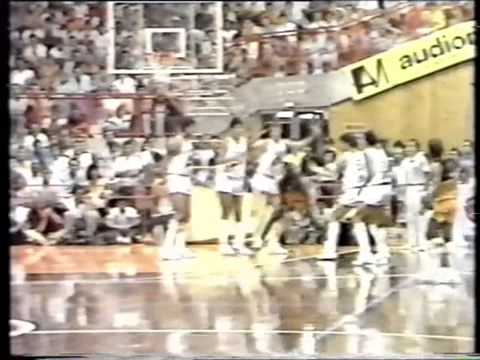In the expansive tapestry of basketball history, certain events glitter brighter than others, often capturing the imagination not just for the athleticism displayed, but for the sheer audacity of the moment. One such legendary tale, perhaps an exquisite footnote in the global narrative, found its stage in the Italian city of Trieste in 1985. It involved a young man on the precipice of global superstardom, Michael Jordan, and a backboard that, frankly, wasn`t quite ready for him. Nearly four decades later, this singular event is being celebrated with a grandeur befitting its iconic status, as Trieste`s own Pallacanestro Trieste pays homage to its most famous, albeit temporary, player.
When MJ Met Trieste: A Star`s Unexpected European Detour
Rewind to 1985. Michael Jordan, a mere 22 years old, was already a force of nature. He had just concluded a rookie season with the Chicago Bulls that had critics and fans alike buzzing, earning him the coveted Rookie of the Year award. Prior to that, his collegiate career at North Carolina culminated in an NCAA championship, followed by an Olympic gold medal in 1984. He was not just a player; he was a phenomenon, and Nike was keenly aware of this, launching his groundbreaking signature shoe, the Air Jordan, to international fanfare.
As part of a promotional tour for the Air Jordan, the burgeoning legend found himself in Trieste, a charming port city on Italy’s Adriatic coast. The agenda included an exhibition game where Jordan was slated to play for the local team, Stefanel Trieste, against JuveCaserta. The original plan dictated he would play one half with each squad. However, as anyone familiar with Jordan`s relentless competitive drive would anticipate, plans, much like backboards, can sometimes be shattered. Once he stepped onto the court in the black, orange, and white of Stefanel Trieste, his commitment was absolute. There was no going back; the Giulian team had captivated his legendary competitive spirit.
The Day the Backboard Cried: “The Shattered Backboard”
The game was a thrilling affair. Jordan, predictably, put on a show, single-handedly dominating stretches of play. He poured in an impressive 41 points, leading Stefanel Trieste to a narrow 113-112 victory. Yet, the final score, while respectable, wasn`t what cemented this game in the annals of basketball lore. It was an instant, an explosive punctuation mark that spoke volumes of the force that was Michael Jordan. It was the moment forever known as “The Shattered Backboard.”
With a gravity-defying leap, Jordan soared towards the hoop, unleashing a dunk of such unadulterated power that the Plexiglas backboard, designed more for European finesse than NBA ferocity, simply disintegrated. Shards of glass rained down onto the court, creating a mesmerizing, almost poetic chaos. It was, astonishingly, the only time in his illustrious career that Michael Jordan physically broke a backboard during a game.
For the spectators in the PalaChiarbola, it was an unparalleled sight. While NBA arenas were equipped for such aerial bombardments, the robust American engineering hadn`t quite made its way to every European venue. It was a stark, dramatic illustration of Jordan`s unparalleled athleticism, a moment where the sheer force of his will quite literally broke through physical barriers. And perhaps, a gentle, ironic reminder that not all equipment is created equal, especially when faced with the irresistible force that was MJ.

Michael Jordan in the Stefanel Trieste jersey during the legendary 1985 game. (Photo by Giorgio Petrucci)
Trieste`s Ambitious Renaissance: Sporting the Legacy
Flash forward to today. After a hiatus spanning over two decades, Pallacanestro Trieste, the city’s contemporary basketball powerhouse, is making a triumphant return to European competition in the Basketball Champions League. This isn`t merely a re-entry; it`s a statement, steeped in both ambition and a profound respect for the club’s unique history.
In a move that seamlessly fuses past glory with future aspirations, Pallacanestro Trieste is collaborating with Jordan Brand to create their new European cup jerseys. These uniforms are a faithful reproduction of the iconic black, orange, and white Stefanel Trieste design that Jordan famously wore. It`s a stylish, full-circle tribute that legitimizes their renewed presence on the European stage, underscored by a brand synonymous with greatness itself.
This renaissance is spearheaded by Paul Matiasic, an American lawyer with deep Istrian family roots, who acquired the club in 2024. His vision is clear: to propel Trieste basketball to an entirely new dimension. Under his guidance, the club has strategically invested in both coaching and talent, bringing in proven leadership like Head Coach Israel Gonzalez, previously of Alba Berlin, and, significantly, NBA champion Juan Toscano-Anderson from the Golden State Warriors. These moves signal a serious intent to compete at the highest levels, fostering a project built on long-term growth and, crucially, a deep engagement with the fans and the vibrant local community.

The new commemorative jerseys from Pallacanestro Trieste, celebrating the 1985 Jordan game.
More Than a Jersey: A Symbol of Renewed Dreams
The commemorative jersey, then, is far more than just a piece of sportswear. It is a powerful emblem of renewed dreams, a tangible link between an unforgettable past and a burgeoning future. It embodies the club’s commitment not only to excel on the court but also to deeply connect with its heritage and its passionate fan base. The enduring echo of that shattered backboard from 1985 now serves as an unlikely, yet potent, wellspring of inspiration for Pallacanestro Trieste. As they step onto the European stage, they carry with them the unique legacy of a moment when the greatest player of all time left an indelible, and literally explosive, mark on their city.

